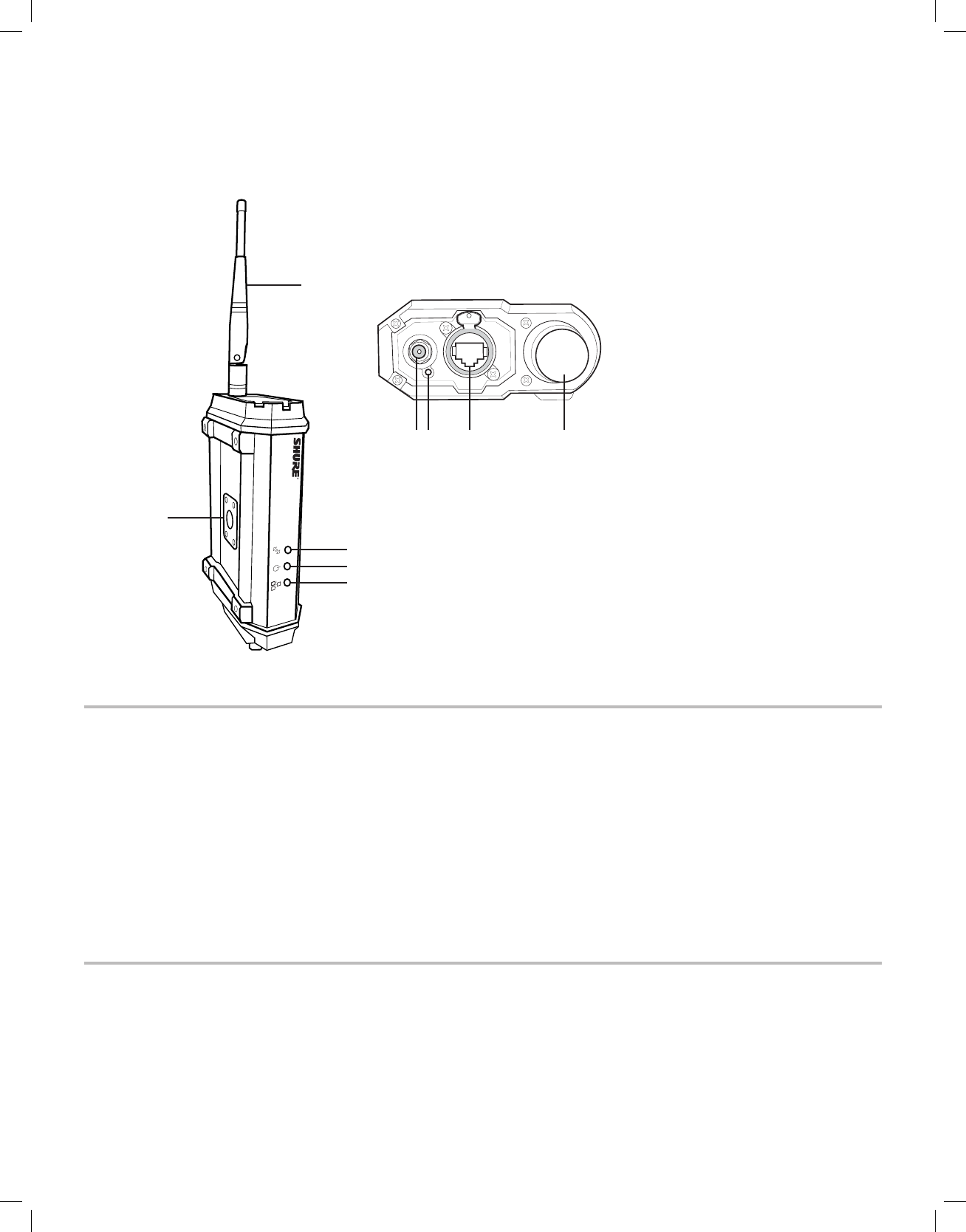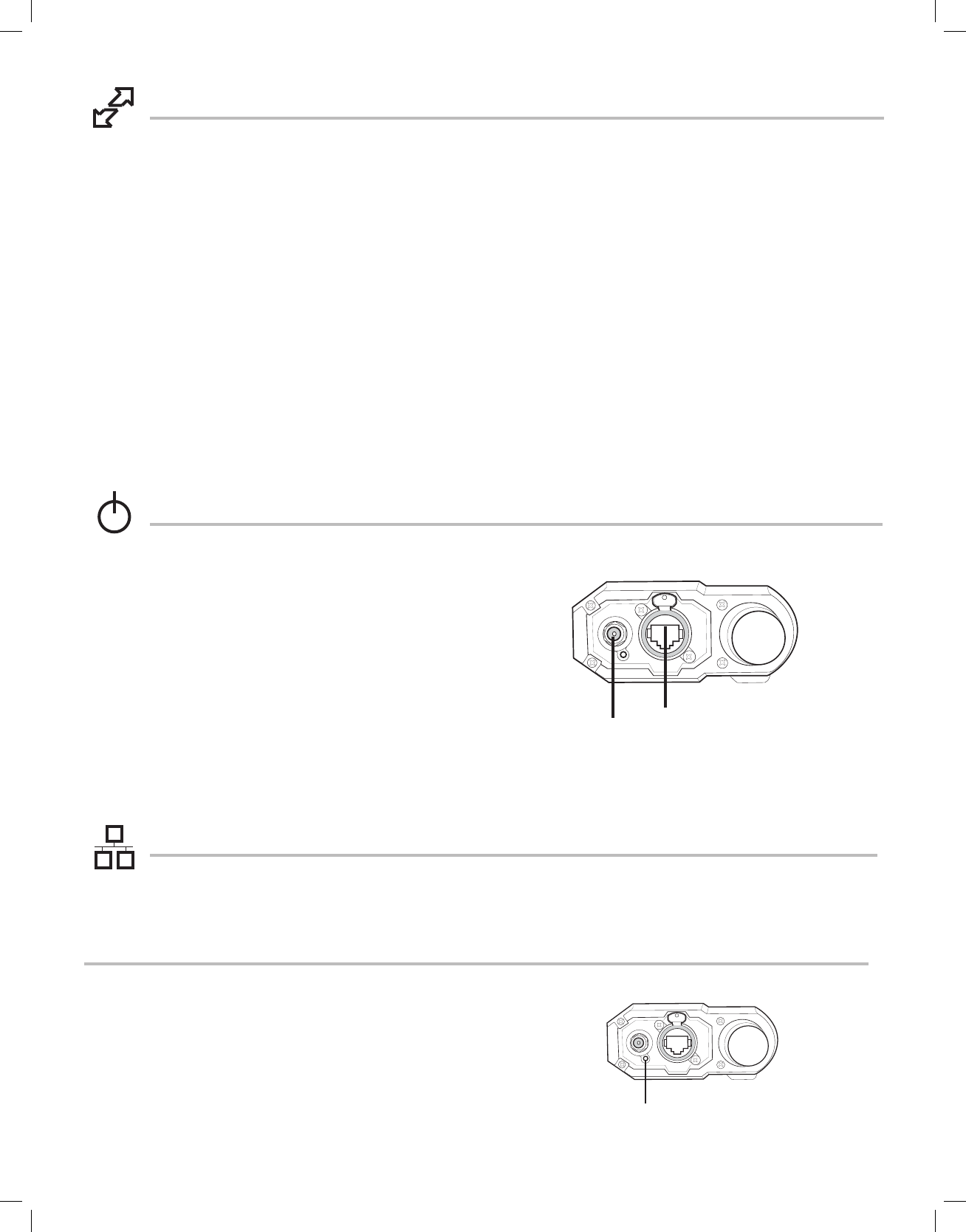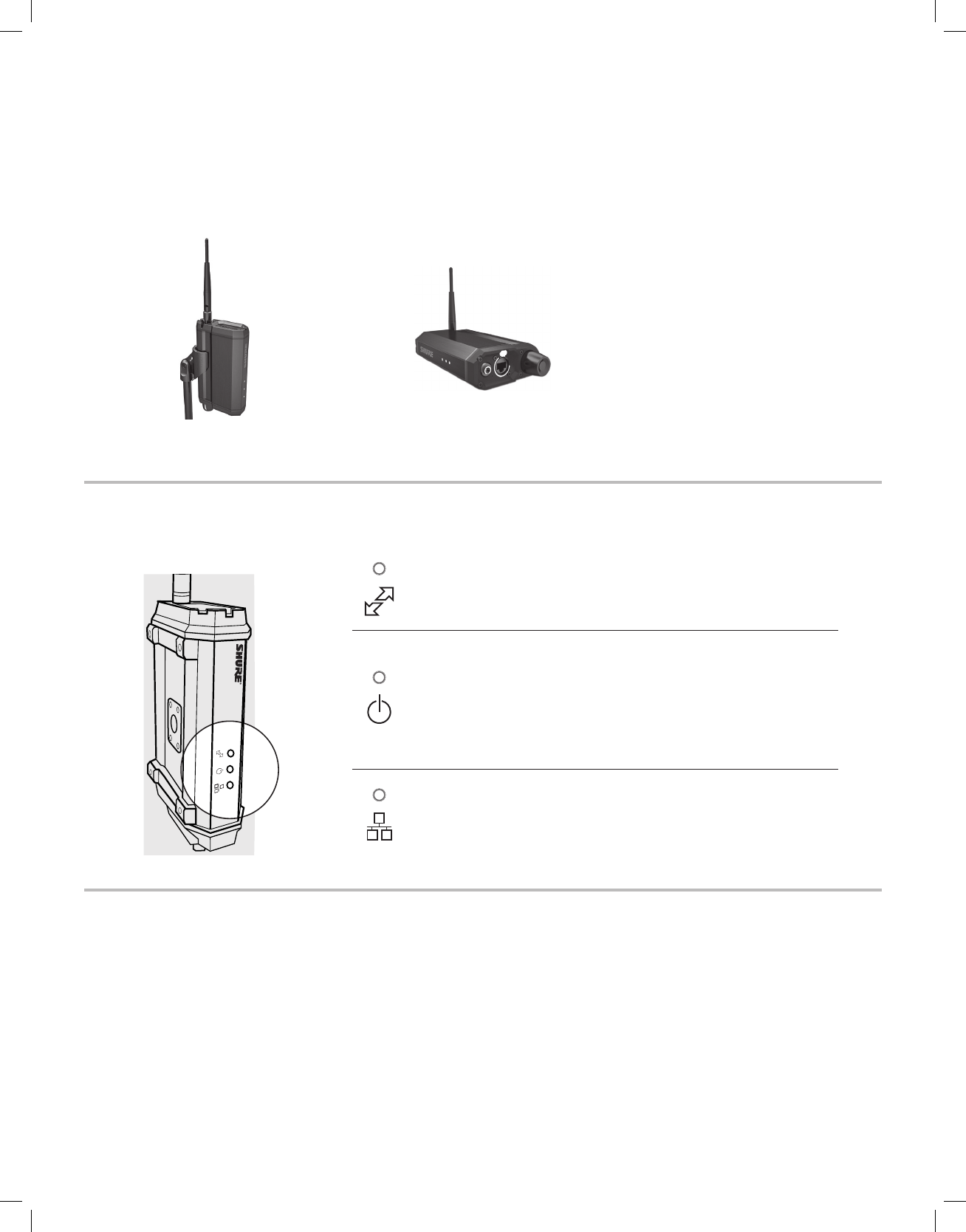Shure orporated AXT610 Wireless Access Point User Manual Exhibit D Users Manual per 2 1033 b3
Shure Incorporated Wireless Access Point Exhibit D Users Manual per 2 1033 b3
Exhibit D Users Manual per 2 1033 b3

1
Revision: 1.3 (12/21/10)
Showlink 2.4 GHz Detachable
Antenna
Showlink Data Status LED
Power Status LED
Ethernet Status LED
Threaded mounting point
External Power Supply Connector
Reset Settings Button
Ethernet Port
Scanning Antenna for Channel
Agility
AXT610 Showlink Wireless Access Point
The AXT610 ShowLink wireless access point delivers real-time wireless control of the Axient transmitters. The access point uses
the 2.4 GHz spectrum to relay parameter changes made at the receiver or in Wireless Workbench 6 to the transmitter. All parameter
changes occur instantly without interrupting the performer.
A single access point can support up to 16 transmitters. Multiple access points can be used to extend the control range or increase
transmitter capacity.
Features
Included Accessories
• Expanded coverage range - coverage range is equal to the
broadcasting range of the transmitters
• Automatic network addressing - DHCP IP addressing automatically
configures the network address
• Reliable performance - the access point uses channel agility to scan
and monitor the quality of the 2.4 GHz communication channel.
If channel quality deteriorates, the access point automatically switches
to a clear frequency
• Remote monitoring - remotely monitor access point status and change
settings using Wireless Workbench (WWB) software
• Real-time wireless control of transmitters - make parameter changes
without interrupting performers
• Simple interface - LEDs instantly show the health of the Showlink
connection, Ethernet data, and the power supply
• High transmitter capacity - control 16 transmitters with a single access
point
• Build an expandable network - increase capacity and coverage by
adding more access points to the network
• Convenient power options - uses power over Ethernet (PoE) supplied
by other Axient components for fewer cables
• WA371 wireless microphone clip for mounting on a mic stand
• Euro thread adapter for WA371
• C825 shielded 25-foot Ethernet cable for ShowLink access point, RJ45 to EtherCon connector
AXT610
Axient Wireless
Showlink Acces Point
PUSH
DRAFT

2
Revision: 1.3 (12/21/10)
Coverage Area
The coverage area of the access point matches the transmitter’s RF
range. Use the ShowLink Test feature in the receiver menu to map
the boundaries of the coverage area. Multiple access points can be
used to increase the coverage area or expand coverage to multiple
rooms.
Transmitter Capacity
A single access point supports up to 16 transmitters. Any transmitter
within range of an active access point with available capacity will be
automatically controlled by that access point. When multiple access
points are used to increase transmitter capacity or increase coverage
range, the network will automatically divide transmitter control between
each access point. All changes in control between access points occur
seamlessly and automatically, without requiring user intervention.
2.4 GHz Command Channel Agility
If the access point experiences interference from Wi-Fi or other
devices sharing the spectrum, channel agility automatically switches
to a clear channel.
Showlink Basics
Power Over Ethernet
The Shure Ethernet switch and Axient rack components offer
Power over Ethernet (PoE) enabled network ports. When the
access point is connected to a PoE enabled network port using
a CAT 5E shielded Ethernet cable, power will automatically be
supplied as long as the host component is powered on.
External Power Supply (Optional)
If power over Ethernet (PoE) is not available, an external power
source supplying 15VDC ±10% (250mA) can power the access point.
1. Connect the power source to the external power supply jack.
2. Tighten the locking ring to secure the plug.
3. Plug the power supply AC line cord into an AC power source.
4. Connect a CAT 5E shielded Ethernet cable to the access point.
Networking
Power
PUSH
Ethernet
Port
External Power
Supply Jack
Reset Option
Reset Button
PUSH
Networking the access point using a Shure Ethernet switch or a DHCP enabled router automatically assigns an IP address, simplifying
network setup. The network connection allows the access point to share data with networked Axient components and enables wireless
control of the transmitters.
Pressing the reset button located on the bottom of the housing
restores the access point to the following settings:
• IP Address Mode = DHCP
• Channel Agility = Enabled
• Device ID = AXT610
• All associated transmitters will be cleared
• Channel Mask = All frequency exclusions will be cleared
ShowLink Channels and 2.4 GHz Spectrum
ShowLink channels that enable remote control of Axient transmitters operate in the 2.40 to 2.484 GHz portion of the RF spectrum in accordance with
the IEEE 802.15.4 protocol. Within the 2.4 GHz spectrum, 16 channels are available for ShowLink communication.
Available spectrum, low interference, and global availability make the 2.4 GHz spectrum an ideal choice for hosting ShowLink channels. Devices that
share the 2.4 GHZ spectrum, including Wi-Fi, are manufactured to efficiently share the spectrum and cause minimal interference.
To ensure reliable communication, the access point contains an internal scanning radio that analyzes the 2.4 GHz spectrum hundreds of times per
second. If interference is detected, the access point uses channel agility to automatically switch to a clear channel within the spectrum. All transmitters
associated with the access point will continue to communicate uninterrupted on the new ShowLink channel.
DRAFT

3
Revision: 1.3 (12/21/10)
Positioning the Access Point
• Provide a clear line of site between the access point and transmitters: mount the access point on a microphone stand or wall to elevate above crowd
level
• Position the antenna vertically for optimal performance. The swivel joint on the antenna allows a wide range of positioning to maintain a vertical
alignment
Status LEDs
LEDs on the side of the housing visually indicate the status the access point and the flow data traffic when the access point is
supporting transmitters.
Control and Configure the Access Point with Wireless Workbench Software
Using WWB 6 software adds the following configuration and networking options for the access point:
• Channel Agility: Enabled or Disabled
• IP Address Mode: DHCP or Manual
• IP Address: Edit in Manual Address Mode
• Edit Device ID
• Set channel exclusion mask: Choose Wi-Fi channels to exclude from use
• View connected transmitters
• View and set a subnet mask
• View and set a gateway
• Reset
Ethernet LED (green)
• ON Steady: Ethernet connected, no traffic
• ON Flashing: Ethernet connected, flashing corresponds to volume of
data traffic.
Power LED (green or amber)
• Steady green: power ON, source = PoE
• Steady amber: power ON, source = external power supply
• OFF = no power
• Red Flashing = response to remote ID flash command
Showlink Data LED (blue)
• ON Steady: OK, no data transmission.
• Flashing: data being transmitted - rate of flashing indicates level of
activity.
There are three mounting options:
AXT610
Axient Wireless
Showlink Acces Point
i
i
i
i
i
i
i
i
i
i
i
i
i
i
i
i
i
i
i
i
i
i
i
i
i
i
i
i
i
i
i
i
i
i
i
i
i
i
i
i
i
i
Microphone Stand Mount Horizontal Mount Wall Mount
DRAFT

4
Revision: 1.3 (12/21/10)
Specifications
Antenna Type Omnidirectional
Access Point Capacity 16 transmitters
Modulation Type OQPSK
Channel Width 5 MHz
Mounting Type WA371 Mic Clip
Operating Temperature Range -18°C (0°F) to 63°C (145°F)
Storage Temperature Range -29°C (-20°F) to 74°C (165°F)
Dimensions 186 mm x 101 mm x 46 mm (7.34in.3.960in.1.825in.
Weight 476.3 g (16.8 oz.) (without antenna )
Housing Extruded Aluminum
Power Requirements Power over Ethernet (PoE) Class 1: 36 to 58 VDC/VAC
External Power Supply(PoE Unavailable): 15VDC ±10% (250mA)
Showlink
Network Type IEEE 802.15.4
Frequency Range 2.40 to 2.484 GHz
RF Output Power 10 dBm ERP
RF Sensitivity -108 dBm , typical
Working Range Under typical conditions: 100 m (330 ft)
Line of Sight, outdoors for a single system: 500 m (1600 ft)
Note: Actual range depends on RF signal absorption, reflection and interference.
Antenna Connection
Connector SMA
Impedance 50 Ω
Scanning Radio
Scanner RF Sensitivity -106 dBm , typical
Networking
Network Interface Ethernet 10/100
DRAFT

5
Revision: 1.3 (12/21/10)
AXT610: Certified under FCC Part 15 (FCC ID: DD4AXT610). Certified by IC in Canada under RSS-210 (IC: 616A-AXT610).
Transmitters must be installed to provide a minimum separation distance of 20 cm from all persons.
The CE Declaration of Conformity can be obtained from: www.shure.com/europe/compliance
Certification
Information to User
This equipment has been tested and found to comply with the limits for a Class B digital device, pursuant to Part 15 of the FCC Rules. These limits are
designed to provide reasonable protection against harmful interference in a residential installation. This equipment generates, uses and can radiate radio
frequency energy and, if not installed and used in accordance with the instructions, may cause harmful interference to radio communications. However,
there is no guarantee that interference will not occur in a particular installation. If this equipment does cause harmful interference to radio or television
reception, which can be determined by turning the equipment off and on, the user is encouraged to try to correct the interference by one or more of the
following measures:
• Relocate the receiving antenna.
• Increase the separation between the equipment and receiver.
• Connect the equipment into an outlet on a circuit different from that to which the receiver is connected.
• Consult the dealer
This Class B digital apparatus complies with Canadian ICES-003.
Cet appareil numérique de la classe B est conforme à la norme NMB-003 du Canada.
Operation of this device is subject to the following two conditions:
(1) this device may not cause interference, and (2) this device must accept any interference, including interference that may cause undesired operation
of the device.
Note: EMC conformance testing is based on the use of supplied and recommended cable types. The use of other cable types may degrade EMC
performance.
DRAFT